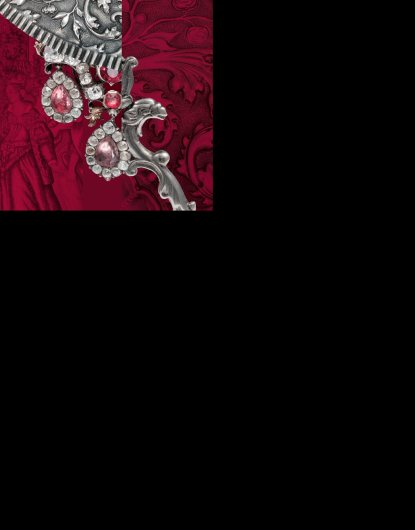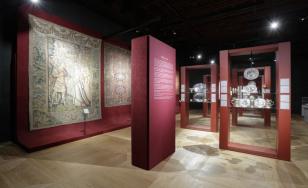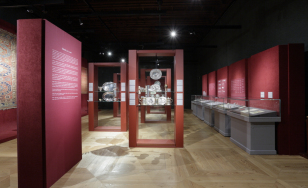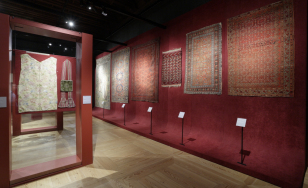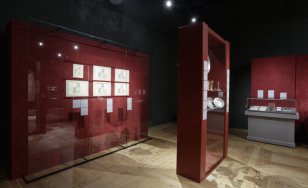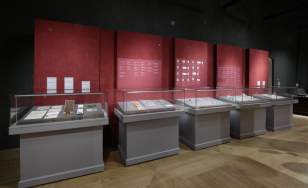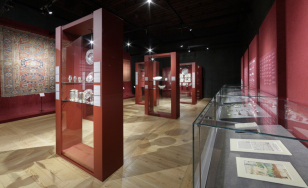Acquisitions 2017–2018
Temporary exhibition: April 9 – June 30, 2019
Wawel Royal Castle is pleased to showcase acquisitions made in 2017 and 2018.
Goldsmiths’ work, small decorative art objects, as well as seals and medals were acquired in the greatest numbers. Especially noteworthy are our acquisitions of precious gold and silver objects created in the 16th through 18th centuries in leading Western European (Nuremberg, Augsburg) and Polish (Gdańsk, Toruń) workshops. Among them are imposing tankards, cups, and salvers, as well as luxurious objects of vertu such as small caskets, cases for utensils, and snuff boxes. The Castle’s porcelain collection gained two very fine pieces made in the Meissen Royal Porcelain Manufactory in the first half of the 18th century – a tea caddy with harbor views and a serving dish with East Asian decorative motifs.
The Textile Department’s acquisitions constitute an interesting group of works in the show. The most significant among them is a tapestry with a scene from the story of Dido and Aeneas from a Trojan Warthemed series. It was woven in the Brussels workshop of Nicasius Aerts in the early 17th century. We also acquired a group of Persian and Central Asian textiles from the late 19th through early 20th centuries.
In addition to tapestries, Wawel holds one of Poland’s foremost collections of kontusz sashes. Most often made of richly colored and patterned silk interwoven with gold or silver thread, sashes were an essential component of the national dress of Polish noblemen. With the addition of the recently acquired sash woven in 1781–1784 in the important Polish manufactory at Kobyłka, our collection now numbers 57 pieces.
Through auction purchases made abroad, the Wawel Royal Castle has assembled an important collection of the insignia of Polish orders and decorations: the Order of the White Eagle, the Order of Saint Stanislaus, and the Military Order Virtuti Militari. These include crosses and breast stars dating from before the partitions and from the period of the Duchy of Warsaw.
Wawel’s sigillography collection was greatly enlarged by the addition of a number of seals and seal matrices bearing the coats of arms of Polish noble families.
The Metalwork Department acquired a number of vessels and pewterware. A rarity among them is a medieval brass ablution jug from the first half of the 15th century.
A group of documents and heirloom objects belonging to Professor Jerzy Szablowski (1906–1989), director of the Wawel Royal Castle – State Art Collection from 1952 to 1989, makes a significant addition to the documentation of the Wawel museum’s history. Among the several dozen items are membership cards from various institutions, associations, and organizations; documentation of orders and distinctions he had received; certificates and documents, including some from World War II; and twelve medals and commemorative badges and from 1965–1986.
Wawel Royal Castle is pleased to showcase acquisitions made in 2017 and 2018.
Goldsmiths’ work, small decorative art objects, as well as seals and medals were acquired in the greatest numbers. Especially noteworthy are our acquisitions of precious gold and silver objects created in the 16th through 18th centuries in leading Western European (Nuremberg, Augsburg) and Polish (Gdańsk, Toruń) workshops. Among them are imposing tankards, cups, and salvers, as well as luxurious objects of vertu such as small caskets, cases for utensils, and snuff boxes. The Castle’s porcelain collection gained two very fine pieces made in the Meissen Royal Porcelain Manufactory in the first half of the 18th century – a tea caddy with harbor views and a serving dish with East Asian decorative motifs.
The Textile Department’s acquisitions constitute an interesting group of works in the show. The most significant among them is a tapestry with a scene from the story of Dido and Aeneas from a Trojan Warthemed series. It was woven in the Brussels workshop of Nicasius Aerts in the early 17th century. We also acquired a group of Persian and Central Asian textiles from the late 19th through early 20th centuries.
In addition to tapestries, Wawel holds one of Poland’s foremost collections of kontusz sashes. Most often made of richly colored and patterned silk interwoven with gold or silver thread, sashes were an essential component of the national dress of Polish noblemen. With the addition of the recently acquired sash woven in 1781–1784 in the important Polish manufactory at Kobyłka, our collection now numbers 57 pieces.
Through auction purchases made abroad, the Wawel Royal Castle has assembled an important collection of the insignia of Polish orders and decorations: the Order of the White Eagle, the Order of Saint Stanislaus, and the Military Order Virtuti Militari. These include crosses and breast stars dating from before the partitions and from the period of the Duchy of Warsaw.
Wawel’s sigillography collection was greatly enlarged by the addition of a number of seals and seal matrices bearing the coats of arms of Polish noble families.
The Metalwork Department acquired a number of vessels and pewterware. A rarity among them is a medieval brass ablution jug from the first half of the 15th century.
A group of documents and heirloom objects belonging to Professor Jerzy Szablowski (1906–1989), director of the Wawel Royal Castle – State Art Collection from 1952 to 1989, makes a significant addition to the documentation of the Wawel museum’s history. Among the several dozen items are membership cards from various institutions, associations, and organizations; documentation of orders and distinctions he had received; certificates and documents, including some from World War II; and twelve medals and commemorative badges and from 1965–1986.
